Ah, the joys of spending time outdoors during the warmer months – picnics, hikes, and barbecues, all under the sun-kissed sky. But wait, what’s that buzzing sound? It’s a wasp! As the weather warms up and we spend more time outside, encounters with wasps become increasingly likely. These stinging insects can be fascinating to observe from a safe distance. However, a close encounter with a wasp can quickly turn painful if you end up with a sting. Knowing how to identify and treat a wasp sting can help you stay safe and comfortable during your outdoor adventures. Keep reading to learn the key indicators of wasp stings and how to treat them.
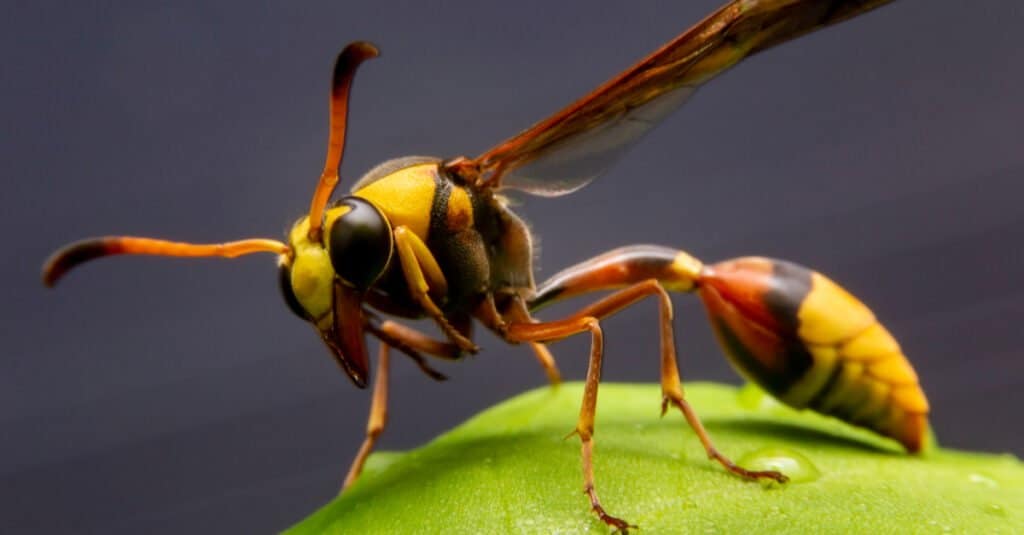
The sting of a paper wasp (
Vespidae) can pack a wallop!
©Witsawat.S/Shutterstock.com
What is a Wasp?
A wasp is an insect that belongs to the order Hymenoptera, which also includes ants and bees. There are many different species of wasps. Wasps are found all over the world in a wide variety of habitats, from deserts to forests. Wasps are characterized by their slender, narrow bodies, and characteristic waists. Their wings are folded lengthwise when at rest. They have powerful jaws that they use to capture prey, such as other insects, spiders, and even small vertebrates.
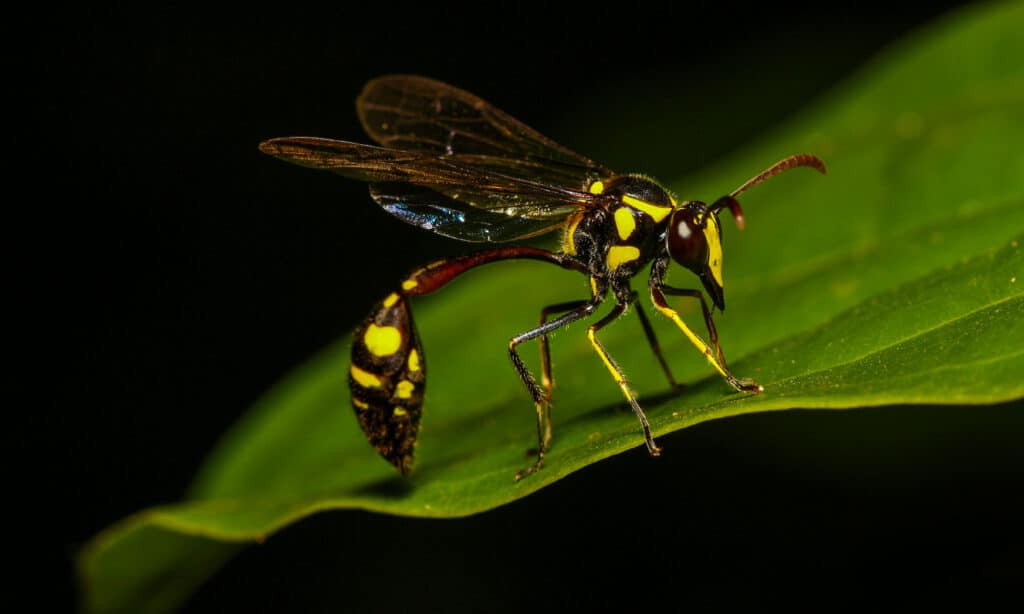
Wasps are characterized by their slender, narrow bodies, and characteristic waists.
©Preecha Ngamsrisan/Shutterstock.com
Unlike bees, which feed on nectar and pollen, wasps are typically predators or parasitoids. Wasps lay their eggs on or inside other insects, which serve as food sources for their developing young. However, some species of wasps are also important pollinators, playing a crucial role in the reproduction of many plants. While wasps are generally beneficial to ecosystems, they can also be a nuisance. Some species, such as yellowjackets and hornets, are aggressive and have painful stings. These stings can cause severe allergic reactions in some people.

Some species, such as the yellowjacket (
Vespidae), are aggressive and have painful stings.
©Ernie Cooper/Shutterstock.com
Wasp Stings: A Special Feature
One of the distinguishing features of wasps is their ability to sting repeatedly, unlike bees which can only sting once. This is because the stinger of a wasp is not barbed like that of a bee. Therefore, it can retract after a sting, allowing the wasp to sting again should it choose to do so. The ability to sting repeatedly is an important defense mechanism for wasps. It allows them to protect themselves and their nests from potential threats. When a wasp stings, it injects venom into the skin of its victim. This can cause pain, swelling, and other symptoms. However, that wasps can sting repeatedly also means that they can be more dangerous than bees in certain situations.

A distinguishing feature of wasps is their ability to sting repeatedly, like the
Asian giant hornet
(
Vespa mandarinia).
©Brais Seara/Shutterstock.com
If a person accidentally disturbs a wasp nest or comes into close proximity to a group of aggressive wasps, they may be stung multiple times, potentially leading to a more severe reaction. It is important to take precautions when dealing with wasps to minimize the risk of being stung. This may include avoiding areas where wasps are known to nest, wearing protective clothing when working outside, and using insect repellent to keep wasps at bay.
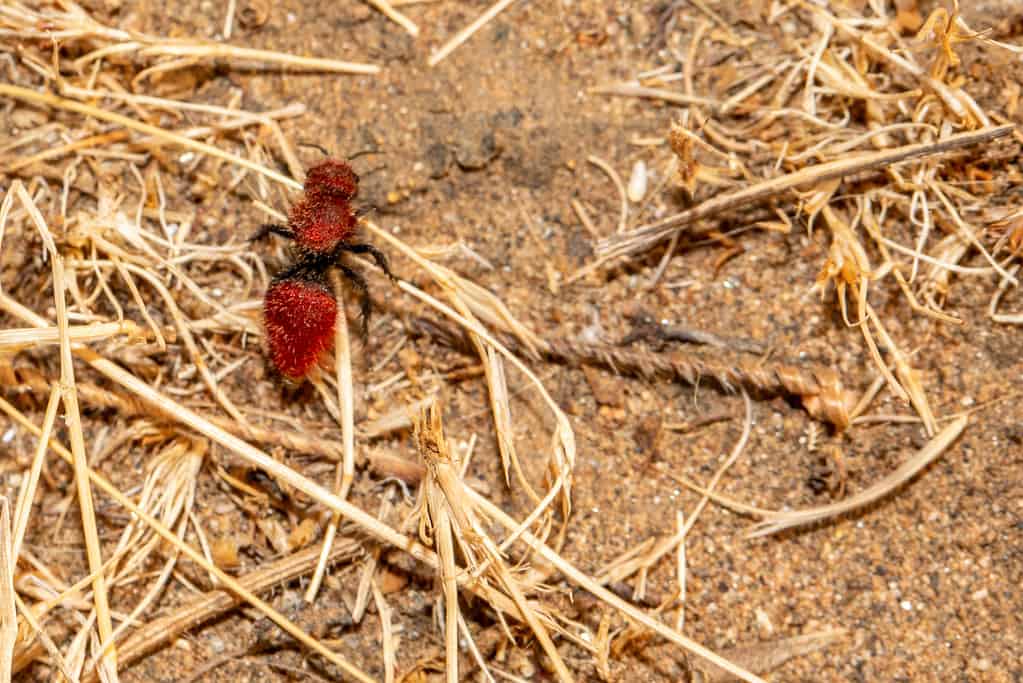
The red velvet ant (
Dasymutilla occidentalis) is actually a wingless wasp with an excruciatingly painful sting.
©Warren Parker/Shutterstock.com
Wasp Stings: What They Look Like
A wasp sting looks like a small, red bump on the skin, similar to a mosquito bite. However, a wasp sting can be more painful and swollen than a mosquito bite. The area around the sting may also feel warm to the touch. There may be some itching or irritation. A severe reaction to a wasp sting can cause a larger area of redness and swelling around the sting. This is because a more severe sting typically involves a greater amount of venom being injected into the skin, which can trigger a stronger immune response.
The size of the red and warm area around a wasp sting can vary depending on factors such as the individual’s sensitivity to the venom, the location of the sting, and the number of stings received. In some cases, a more severe allergic reaction can occur. Hives, difficulty breathing, or anaphylaxis, are all possible reactions to a wasp sting.
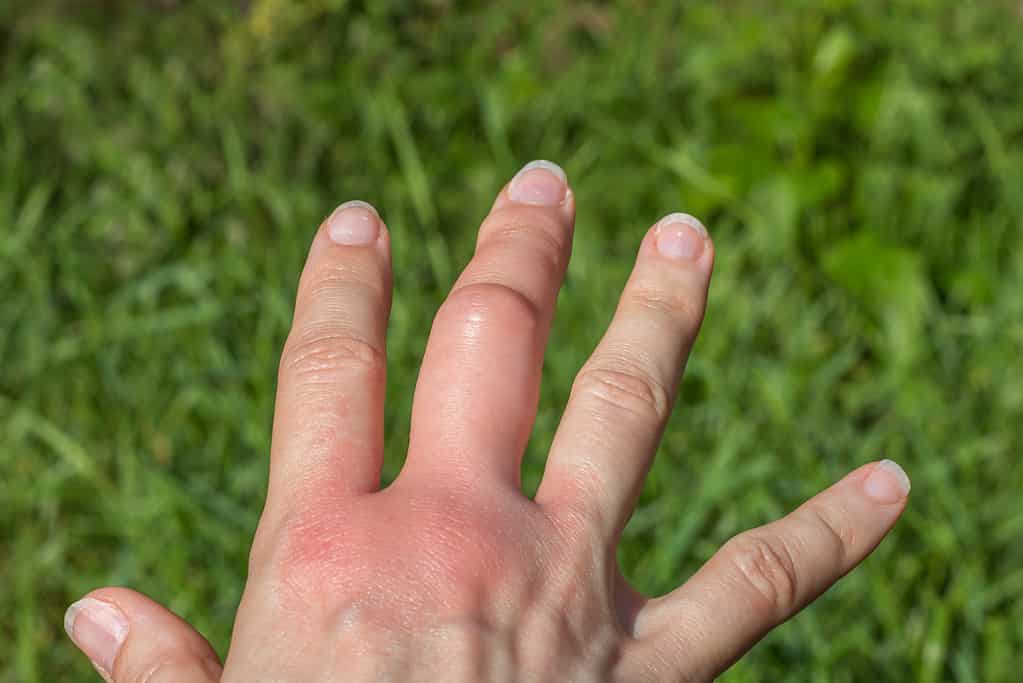
A severe reaction to a wasp sting can cause a larger area of redness and swelling around the sting.
©iStock.com/Inna Kozhina
It is important to monitor the sting site and any symptoms closely after being stung by a wasp. Seek medical attention if you experience any signs of a severe reaction, such as swelling of the face or throat, difficulty breathing, or a rapid heartbeat.
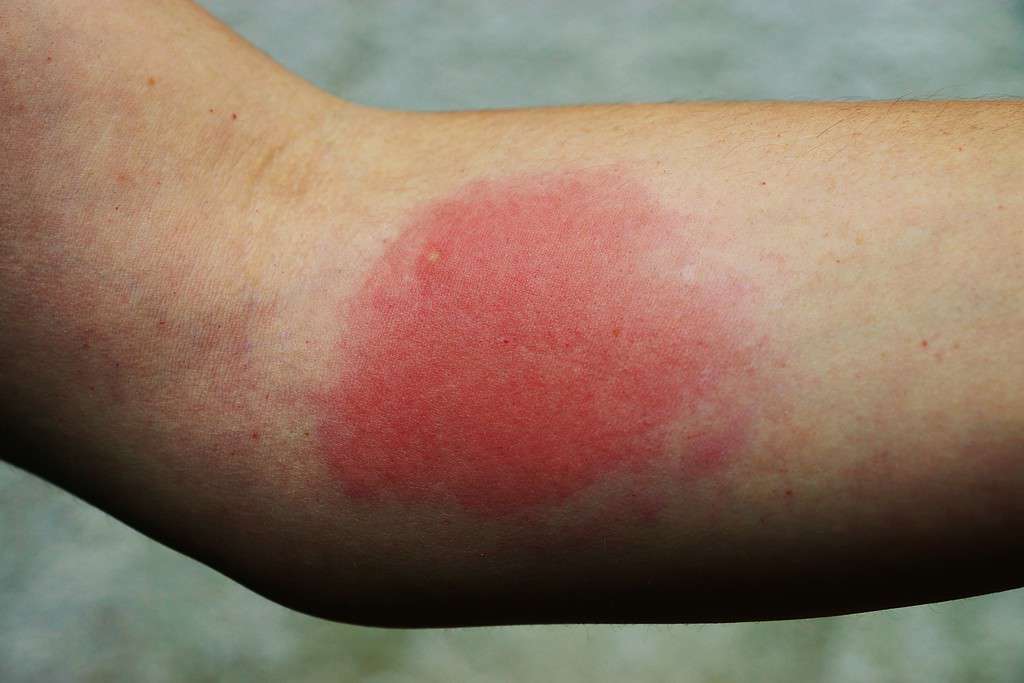
A more severe sting typically involves a greater amount of venom being injected into the skin, which can trigger a stronger immune response.
©
Wasp Stings: How to Treat
The protocol for treating wasp stings depends on the severity of the reaction. For a mild reaction, the following steps can be taken:
- Remove the stinger: If there is a visible stinger, gently scrape it out of the skin with a flat object such as a credit card. Avoid squeezing or pinching the stinger, as this can cause more venom to be released into the skin. As a rule, wasp stings will not contain a stinger, but there are exceptions to every rule and an ounce of prevention is worth a pound of cure.
- Clean the area: Wash the sting site with soap and water to help prevent infection.
- Apply a cold compress: Place a cold, damp cloth or an ice pack on the sting site to help reduce swelling and pain. Keep the compress on for 10-15 minutes at a time, several times a day as needed.
- Baking soda paste: Applying baking soda paste to wasp stings alleviates the associated pain and swelling. Baking soda, or sodium bicarbonate, is a naturally alkaline substance that can neutralize the acidic venom of a wasp sting, thereby reducing pain and swelling. To make a baking soda paste, mix a small amount of baking soda with water until a thick paste has formed. Apply the paste to the affected area and leave it on for 15 – 20 minutes before rinsing it off with cool water.
- Take over-the-counter pain relievers: Over-the-counter pain relievers can help alleviate pain and reduce inflammation.
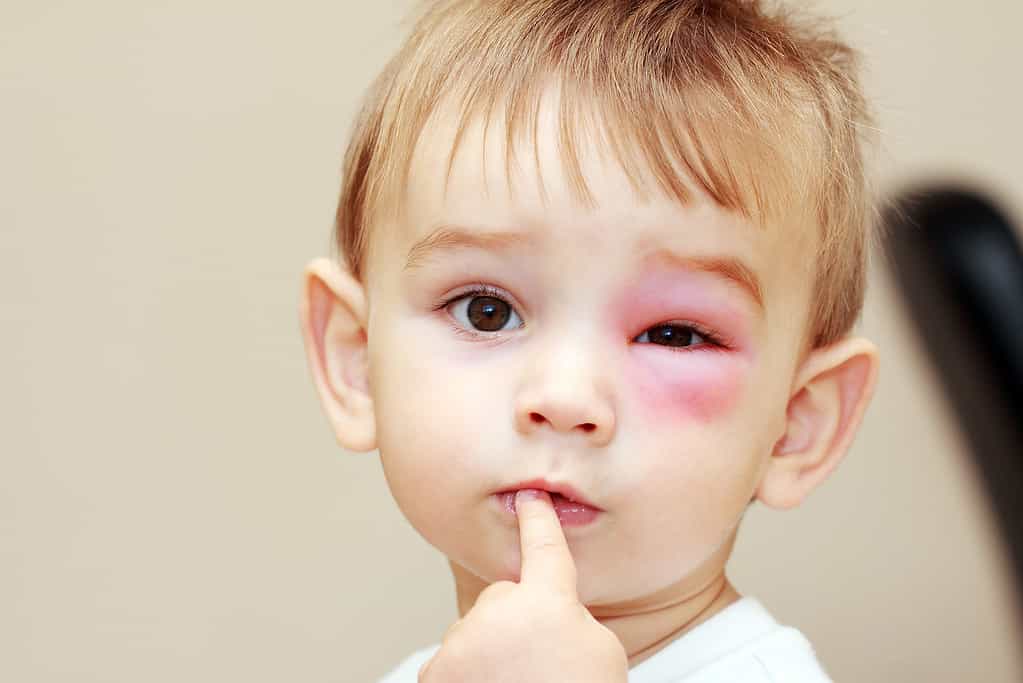
Over-the-counter pain relievers can help alleviate pain and reduce inflammation.
©Beneda Miroslav/Shutterstock.com
Recommended Treatment for Severe Reactions
For a more severe reaction, such as anaphylaxis, the following steps should be taken. If you have a known allergy to insect venom or have experienced a severe reaction to a wasp sting in the past, it is recommended that you carry an epinephrine auto-injector, aka epi-pen, with you at all times. Steps to take if stung:
- Seek emergency medical attention immediately: If you experience symptoms such as difficulty breathing, swelling of the face or throat, rapid heartbeat, or dizziness, seek emergency medical attention immediately.
- Use an epinephrine auto-injector: If you have been prescribed an epi-pen, use it immediately as directed and seek medical attention right away.
- Follow up with a healthcare provider: Even if you have used an epi-pen and are feeling better, it is important to follow up with a healthcare provider to ensure proper treatment and management of your condition.
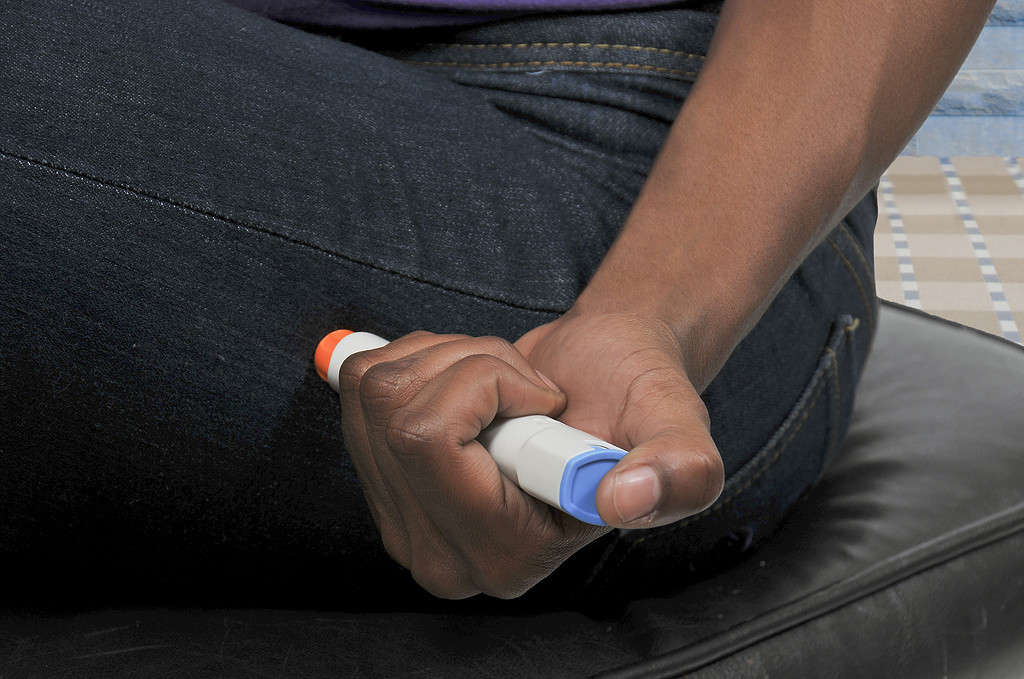
If you have been prescribed an epi-pen, use it immediately as directed and seek medical attention right away.
©Rob Byron/Shutterstock.com
Precautionary Measures
Taking precautions can help minimize the risk of being stung by a wasp, and allow you to enjoy your time outdoors. There are certain colors of clothing that you should avoid wearing around wasps as they are attracted to them. Wasps are attracted to bright colors, especially green, pink, purple, white, and yellow. Avoid wearing bright or floral-patterned clothing when spending time outdoors in areas where wasps may be present. Instead, it is best to wear light, solid-colored clothing such as beige, khaki, or gray. These colors are less likely to attract wasps. Avoid using fragrances such as perfumes, colognes, and scented lotions, as these can also attract wasps. It is also recommended to avoid wearing loose-fitting clothing or clothing with exposed skin, as this can make it easier for wasps to sting.

It is best to wear light-colored, solid clothing such as beige, khaki, or gray, as these colors are less likely to attract wasps.
©Wandel Guides/Shutterstock.com
The photo featured at the top of this post is © Robert Briggs/Shutterstock.com
Thank you for reading! Have some feedback for us? Contact the AZ Animals editorial team.






